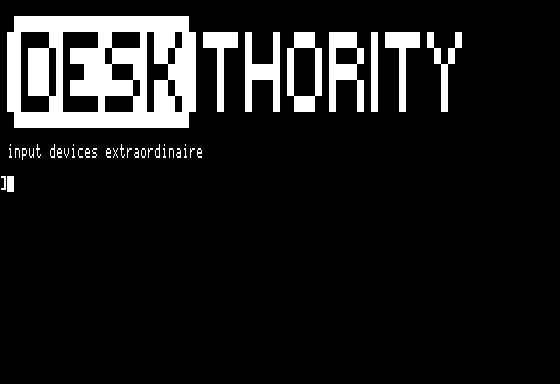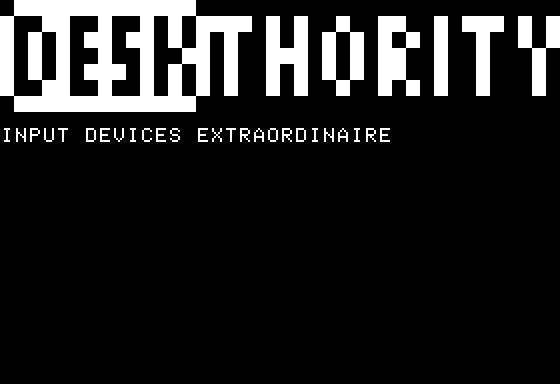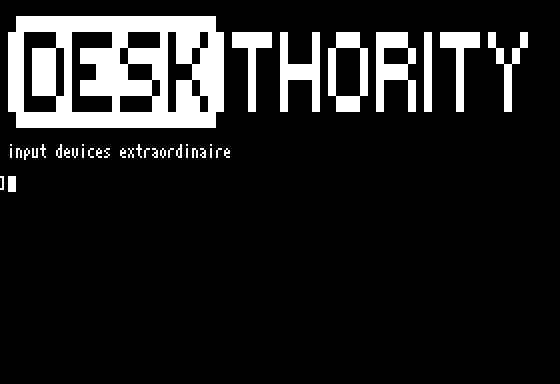Deskthority Logo ANSI
- Daniel
- Location: Blackforest Germany
- Main keyboard: Various
- Main mouse: Kensington Slimblade + MX518
- Favorite switch: Cherry MX Blue and Black + BS
- DT Pro Member: 0028
After watching this: http://www.youtube.com/watch?v=ILNs1GChGDk
I was bored and made this with PabloDraw (which runs nicely under Linux):
I was bored and made this with PabloDraw (which runs nicely under Linux):
- Attachments
-
- DESKTHORITY.ans.zip
- (400 Bytes) Downloaded 177 times
- nathanscribe
- Location: Yorkshire, UK.
- Main keyboard: Filco tenkeyless w/blues
- Main mouse: Kensington Expert
- Favorite switch: MX Blue
- DT Pro Member: -
Oh, I'd love an 8-bit mode for this site...
- bhtooefr
- Location: Newark, OH, USA
- Main keyboard: TEX Shinobi
- Main mouse: TrackPoint IV
- Favorite switch: IBM Selectric (not a switch, I know)
- DT Pro Member: 0056
- Contact:
Hell, that logo could display on anything that has an inverse mode, not just ANSI.
- webwit
- Wild Duck
- Location: The Netherlands
- Main keyboard: Model F62
- Favorite switch: IBM beam spring
- DT Pro Member: 0000
- Contact:
Twenty years ago I was an ASCII artist (before the www ruined it all). We only need 7-bit.
-
Findecanor
- Location: Stockholm, Sweden
- DT Pro Member: 0011
Earlier this summer, I attended a demo party (first time for me for .. 18 years). There was an ANSI competition at the party. 
- webwit
- Wild Duck
- Location: The Netherlands
- Main keyboard: Model F62
- Favorite switch: IBM beam spring
- DT Pro Member: 0000
- Contact:
This exquisite piece of art is called Supernova and has 12 layers of 3D *. Bidding starts at $200. Made on AMIGA!

* Really.

* Really.
- bhtooefr
- Location: Newark, OH, USA
- Main keyboard: TEX Shinobi
- Main mouse: TrackPoint IV
- Favorite switch: IBM Selectric (not a switch, I know)
- DT Pro Member: 0056
- Contact:
Code: Select all
10 PR# 3: NORMAL : HOME
15 PRINT
20 VTAB 2: GOSUB 7000
30 VTAB 3: HTAB 2: PRINT " ";: HTAB 8: PRINT " ";: HTAB 15: PRINT " ";: HTAB 21: PRINT " ";: HTAB 23: PRINT " ";: HTAB 27: PRINT " ";
31 HTAB 30: PRINT " ";: HTAB 36: PRINT " ";: HTAB 40: PRINT " ";: HTAB 43: PRINT " ";: HTAB 48: PRINT " ";: HTAB 54: PRINT " ";: HTAB 56: PRINT " ";: HTAB 62: PRINT " ";: HTAB 66: PRINT " "
40 VTAB 4: HTAB 2: PRINT " ";: HTAB 5: PRINT " ";: HTAB 9: PRINT " ";: HTAB 11: PRINT " ";: HTAB 17: PRINT " ";: HTAB 23: PRINT " ";: HTAB 26: PRINT " ";
41 GOSUB 7100: HTAB 63: PRINT " ";: HTAB 65: PRINT " "
50 VTAB 5: HTAB 2: PRINT " ";: HTAB 5: PRINT " ";: HTAB 9: PRINT " ";: HTAB 13: PRINT " ";: HTAB 20: PRINT " ";: HTAB 25: PRINT " ";
51 HTAB 32: PRINT " ";: HTAB 36: PRINT " ";: HTAB 42: PRINT " ";: HTAB 46: PRINT " ";: HTAB 48: PRINT " ";: HTAB 54: PRINT " ";: HTAB 58: PRINT " ";: HTAB 64: PRINT " "
60 VTAB 6: HTAB 2: PRINT " ";: HTAB 5: PRINT " ";: HTAB 9: PRINT " ";: HTAB 11: PRINT " ";: HTAB 21: PRINT " ";: HTAB 23: PRINT " ";: HTAB 26: PRINT " ";
61 GOSUB 7100: HTAB 64: PRINT " "
70 VTAB 7: HTAB 2: PRINT " ";: HTAB 8: PRINT " ";: HTAB 15: PRINT " ";: HTAB 20: PRINT " ";: HTAB 23: PRINT " ";: HTAB 27: PRINT " ";
71 HTAB 32: PRINT " ";: HTAB 36: PRINT " ";: HTAB 40: PRINT " ";: HTAB 43: PRINT " ";: HTAB 48: PRINT " ";: HTAB 52: PRINT " ";: HTAB 54: PRINT " ";: HTAB 58: PRINT " ";: HTAB 64: PRINT " "
80 VTAB 8: GOSUB 7000
100 NORMAL : VTAB 10: HTAB 2: PRINT "input devices extraordinaire"
6502 END
7000 HTAB 3: INVERSE : PRINT " ": RETURN
7100 HTAB 32: PRINT " ";: HTAB 36: PRINT " ";: HTAB 40: PRINT " ";: HTAB 42: PRINT " ";: HTAB 46: PRINT " ";: HTAB 48: PRINT " ";: HTAB 52: PRINT " ";: HTAB 54: PRINT " ";: HTAB 58: PRINT " ";: RETURN

- Halvar
- Location: Baden, DE
- Main keyboard: IBM Model M SSK / Filco MT 2
- Favorite switch: Beam & buckling spring, Monterey, MX Brown
- DT Pro Member: 0051
Wow, having an Amiga and doing this dossy textmode stuff should have been forbidden! 
Amigas could do this:
(the scratching of the FDD is missing)
Having written simple textmode games in GWBasic at school and on the C64 at home, I was happy that the ASCII days were over in 1988 already when I got my Amiga ... And I still am.
Amigas could do this:
(the scratching of the FDD is missing)
Having written simple textmode games in GWBasic at school and on the C64 at home, I was happy that the ASCII days were over in 1988 already when I got my Amiga ... And I still am.
- webwit
- Wild Duck
- Location: The Netherlands
- Main keyboard: Model F62
- Favorite switch: IBM beam spring
- DT Pro Member: 0000
- Contact:
Yes, but I used my Amiga in the early nineties to connect to the Internet. Which was text only.
- bhtooefr
- Location: Newark, OH, USA
- Main keyboard: TEX Shinobi
- Main mouse: TrackPoint IV
- Favorite switch: IBM Selectric (not a switch, I know)
- DT Pro Member: 0056
- Contact:
Plus a lot of people, at least in the US, used BBSes back then. Also text only.
- webwit
- Wild Duck
- Location: The Netherlands
- Main keyboard: Model F62
- Favorite switch: IBM beam spring
- DT Pro Member: 0000
- Contact:
I once was in the Amiga *cough* demo scene too. When men used assembler and not something lame as C. Before I was lured by the Internet and MUD in particular.
- Halvar
- Location: Baden, DE
- Main keyboard: IBM Model M SSK / Filco MT 2
- Favorite switch: Beam & buckling spring, Monterey, MX Brown
- DT Pro Member: 0051
Real man or Quiche-eater, I was oddly fascinated by GUI programming in C at the time
and the stuff that follows ...
Code: Select all
if !(IntuitionBase=(struct IntuitionBase *)OpenLibrary("intuition.library")) exit(20);-
Findecanor
- Location: Stockholm, Sweden
- DT Pro Member: 0011
ANSI was quite common on BBSes back then, even when used on an Amiga. I think there might even have been BBS programs that ran on the Amiga that used ANSI.bhtooefr wrote:Plus a lot of people, at least in the US, used BBSes back then. Also text only.
- webwit
- Wild Duck
- Location: The Netherlands
- Main keyboard: Model F62
- Favorite switch: IBM beam spring
- DT Pro Member: 0000
- Contact:
BBS was huge in Europe. The cracking groups cracked the software. At first they distributed disks. And put their little intro in front of the game or whatever, for ego and to show off their abilities. Then they started BBS and charged for monthly access or similar setups. Then in Germany payed numbers were introduced, famous for sex lines. But some guys started to use it for their BBS, to offer cracked software for download, charged by the minute. It started to get out of hand when they started buying expensive hardware, and, when old enough, expensive sport cars. This is when the police started to sweep up all these groups, changing the scene forever. A lot of big groups disappeared from west and northern Europe. The remaining ones renamed what they were doing as "demo group". So that's where the name "demoscene" originated.
- Halvar
- Location: Baden, DE
- Main keyboard: IBM Model M SSK / Filco MT 2
- Favorite switch: Beam & buckling spring, Monterey, MX Brown
- DT Pro Member: 0051
Yeah, that became plain crazy. I had a 14.4 kbit/s modem, so I could download about 4 MB in one hour, which cost about 1,80 DM (0,9 €) for a local call, but about 55 DM (27 €) for a long distance call! And "sex hotline" BBS prices were even higher. I was lucky to be able to use a CD burner at work and dial into the Internet at my university pretty early, so I wasn't much into BBSs.
- Daniel Beardsmore
- Location: Hertfordshire, England
- Main keyboard: Filco Majestouch 1 (home)/Poker II backlit (work)
- Main mouse: MS IMO 1.1
- Favorite switch: Probably not whatever I wrote here
- DT Pro Member: -
- Contact:
I see your video and raise you this one:Halvar wrote:Amigas could do this: …
And yes, the Amiga 500 FDD had the best sound of any I've ever heard. (I don't know what DMA did, but Lemmings got a sequence of three tones out of the stepper motor during loading: not sure if deliberate — I don't remember any other changes in long distance track seek timing in any other software.)
(Edit: WTF? Wrong tags …)
Last edited by Daniel Beardsmore on 20 Aug 2013, 01:48, edited 1 time in total.
- nathanscribe
- Location: Yorkshire, UK.
- Main keyboard: Filco tenkeyless w/blues
- Main mouse: Kensington Expert
- Favorite switch: MX Blue
- DT Pro Member: -
Oh wow. Way back we had a school trip to the Media Museum in Bradford to make a 'news broadcast', badly scripted, terrible make-up, etc. I did the title sequence on my 128k Spectrum. It had 3D letters spinning towards the viewer and a rotating planet... took me many hours of programming, and I was dead chuffed with it. No idea where the listing went, or I'd enter it again and make a video. Sigh, the glory days.
- nathanscribe
- Location: Yorkshire, UK.
- Main keyboard: Filco tenkeyless w/blues
- Main mouse: Kensington Expert
- Favorite switch: MX Blue
- DT Pro Member: -
Looks a little sad on the Speccy:
Or:
Really badly coded BASIC, but hey, it's the first one I've written in years:
Or:
Really badly coded BASIC, but hey, it's the first one I've written in years:
- bhtooefr
- Location: Newark, OH, USA
- Main keyboard: TEX Shinobi
- Main mouse: TrackPoint IV
- Favorite switch: IBM Selectric (not a switch, I know)
- DT Pro Member: 0056
- Contact:
Heh, my Apple II Applesoft BASIC code was far uglier. And needs a //e with 80-column card, //c, or IIGS.
I could probably whip it into some more shape by making it draw actual letters, rather than hardcoding each line, and then doing subroutines to automate a couple complex sections.
Edit: 40 columns and not using lowercase, done using T40, meaning that the following code can load it on ANY Apple II:

And, ran the original code (with a tweak to remove the PR#3) using Flex Text, a 20/40/56/70 column graphical console program by Beagle Bros, in 70 column mode - this would run on any Apple II with sufficient RAM and Applesoft ROMs (or a language card, and Applesoft loaded from disk).

I could probably whip it into some more shape by making it draw actual letters, rather than hardcoding each line, and then doing subroutines to automate a couple complex sections.
Edit: 40 columns and not using lowercase, done using T40, meaning that the following code can load it on ANY Apple II:
Code: Select all
10 A=PEEK(49237);REM SWITCHES TO PAGE 2
20 PRINT CHR$(4);"BLOAD DTLOGO,A$800";REM LOADS THE IMAGE ON TOP OF TEXT PAGE 2
And, ran the original code (with a tweak to remove the PR#3) using Flex Text, a 20/40/56/70 column graphical console program by Beagle Bros, in 70 column mode - this would run on any Apple II with sufficient RAM and Applesoft ROMs (or a language card, and Applesoft loaded from disk).
